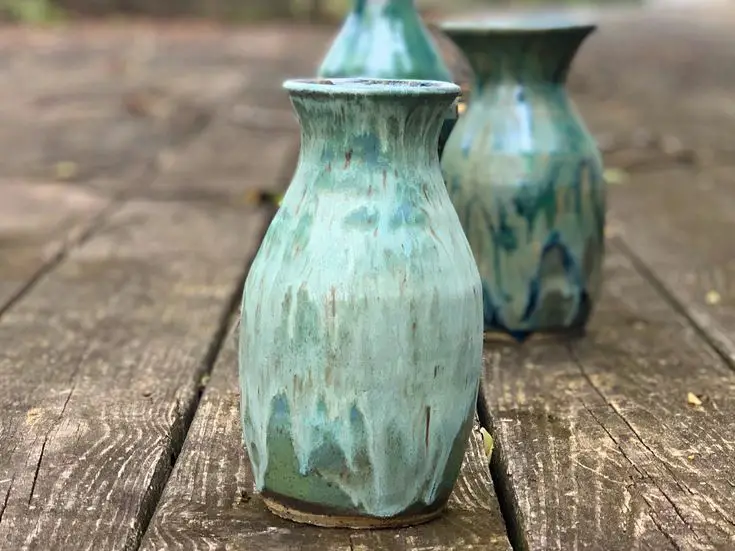What Is Japan’S Finest Pottery?
Japan has a long and rich history of pottery making dating back over 12,000 years. The earliest known pottery vessels were made during the Jomon period (14,500 – 300 BCE). Since then, Japanese ceramics have evolved into a highly refined art form resulting in some of the world’s most exquisite and celebrated styles of pottery.
Key pottery styles that represent the pinnacle of Japanese ceramics include Jomon pottery characterized by rope-patterned surfaces, Haji ware known for its simple and elegant forms, Seto ware which pioneered glazing techniques, Bizen stoneware marked by its rustic ash glazes, Kakiemon decorated with delicate, colorful enamel motifs, Imari pottery distinguished by its blue and white designs, Kutani ware known for its vibrant enamel colors and lavish decoration, and more.
From ancient earthenwares to modern porcelain, Japanese pottery reflects both functional design and artistic mastery passed down through generations of skilled craftsmen. Their enduring creations exemplify Japan’s rich ceramic legacy.
Kilns and Production Centers
Japan has a long history of pottery production, with some kilns dating back over 1000 years.
The Six Ancient Kilns are among the most famous and historically significant production sites in Japan. These include:
- Seto, Aichi Prefecture – Known for glazed ceramics since the 12th century
- Tokoname, Aichi Prefecture – Mass-produced unglazed pottery since the 17th century
- Echizen, Fukui Prefecture – Unglazed stoneware from the 14th century
- Bizen, Okayama Prefecture – Unglazed stoneware from the 12th century
- Shigaraki, Shiga Prefecture – Unglazed pottery since the 12th century
- Tamba, Hyogo Prefecture – Unglazed pottery since the 12th century
Other major historical production centers include Arita in Saga Prefecture, known for porcelain since the 17th century, and Mashiko in Tochigi Prefecture, known for stoneware since the 1890s.
The abundance of high-quality clay across Japan combined with the refinement of techniques over centuries has made Japan one of the world’s foremost pottery producers.
Jomon Pottery

Jomon pottery is considered Japan’s oldest style of pottery, dating back over 10,000 years ago to the Neolithic Jomon period. According to https://www.worldhistory.org/Jomon_Pottery/ Jomon pottery vessels, in the form of simple bowls and pots, were first produced around 13,000 BCE in central Japan, making them among the oldest pottery in the world. What makes Jomon pottery distinct is the cord markings, known as jomon in Japanese, that decorate the surface of the vessels.
These cord impressions were made by pressing rope into the surface of the wet clay and are the defining characteristic of Jomon wares. As noted by https://www.metmuseum.org/toah/hd/jomo/hd_jomo.htm the name Jomon itself means ‘cord-marked’ and refers to these decorative cord-like patterns. Jomon potters shaped their vessels by hand using the coiling technique and then adorned them with abstract patterns by pressing braided rope, sticks, bamboo, or other textured tools into the clay before firing. The cord-marked decoration is a testament to the creativity and artistry of the early Jomon people and represents the beginning of Japan’s distinguished ceramic tradition.
Haji Pottery
Haji ware evolved in the 4th century AD during the Tumulus period from the earlier Yayoi pottery traditions. Haji pottery is known for its simple, elegant style that arose during Japan’s early dynasties. The ornate decorations of Yayoi pottery were reduced to simpler stamped geometric and ripple patterns pressed into the clay before firing. Glazes tended to be monochrome with green, brown, and yellow glazes being common.
Haji pottery production centers were mainly located around Haji village in Yamaguchi prefecture, which gave the style its name. Pieces were formed on a potter’s wheel and fired at high temperatures in Anagama-style climbing kilns. Common vessel forms include wide mouths jars, bowls, and bulbous pots.
Haji ware exemplified the move in Japanese ceramics from purely functional wares towards simple, refined pieces that were valued for their aesthetic qualities. The restrained decoration and forms of Haji pottery went on to influence later Japanese ceramic styles such as Seto, Bizen and Shigaraki.
Seto Pottery
Seto pottery has a long history spanning over 1000 years, with production centered around present-day Nagoya in Aichi prefecture. Seto ware developed from Sue ware produced in the 5th century and is considered one of Japan’s Six Old Kilns.1 The potter Kato Shirozaemon studied ceramic techniques from China in the 1220s and helped establish Seto as a major pottery center. Seto was an important center for glaze research and innovations in the 16th century under the patronage of Oda Nobunaga.2
Seto artisans pioneered new glazing techniques including ash glazing, copper red glazing, iron brown glazing, and crackle glazing. They combined colored glazes in a single piece, like using iron brown on the body and ash glaze on the rim. Seto potters also developed polychrome overglaze enamels and blue-and-white porcelain. The potter Nonomura Ninsei perfected overglaze enamel decoration in the 17th century. His detailed painting and innovative designs brought Seto ware to new artistic heights.
Bizen Pottery
Bizen ware originated in Bizen province in Okayama prefecture and is one of the Six Old Kilns of Japan (https://shop.japanobjects.com/blogs/editorial/bizen-ware). It is known for its simple, unglazed style that highlights the natural beauty of the clay. Bizen pottery dates back to at least the 5th century and experienced a golden age in the 12th-13th centuries when it gained popularity among tea masters (https://en.wikipedia.org/wiki/Bizen_ware).
Bizen ware is fired in Anagama kilns, which are single chamber climbing kilns made from fire-resistant clay and fueled by wood. The pots are not glazed but are fired at very high temperatures of around 1300°C, resulting in natural ash glazes from the wood firing process. The clay turns a warm red-brown color and may have spots, drips or crystals from the ash glaze. The simple, earthy style is reflective of wabi-sabi aesthetic principles.
Today, Bizen remains a leading pottery region in Japan with over 300 active potters. Their works range from tea ceremony utensils to avant-garde sculptures while retaining the distinctive fingerprints and tool marks of the potters (https://www.artisticnippon.com/product/bizen/bizenindex.htm). Bizen’s timeless elegance and artisanal heritage make it one of Japan’s most acclaimed pottery styles.
Kakiemon Pottery
Kakiemon is a style of Japanese porcelain characterized by overglaze decoration called “enameled” ceramics. It was originally produced at potteries around Arita, Saga Prefecture beginning in the mid-17th century. Kakiemon decoration uses colorful enamel motifs of nature like birds, flowers, and seasonal designs combined with geometric shapes. The style is known for its delicate depiction of subject matter and sophisticated combination of colors.
The Kakiemon style was developed by Sakaida Kakiemon, head of a pottery family in Arita. He specialized in enameled porcelain and pioneered new techniques like using a reduced-oxide atmosphere in his kilns to create transparent, glossy enamels. The striking blue-and-white and red-and-white palette became a distinctive feature. At its peak in the late 17th century, Kakiemon ware was exported from the Arita kilns across Europe where it was praised for its delicate beauty.
While pieces like vases and plates were produced for export, Kakiemon ware was also used by the tea ceremony culture in Japan. The style influenced European pottery like Meissen and Chantilly porcelain. Today, Kakiemon continues to be valued for its graceful designs and technical mastery. It represents some of Japan’s most artistic and innovative pottery achievements. (Wikipedia)
Imari Pottery
Imari porcelain, also known as Imari ware, refers to a brightly colored style of Japanese export porcelain produced in the town of Arita in the Saga Prefecture and shipped from the port of Imari between the 17th to 19th centuries [1]. The Imari porcelain became popular in Europe, which referred to the ware as “Imari” because ships departed from the port of Imari. The Japanese themselves called this style of porcelain “Arita ware” [2].
The Imari porcelain was highly coveted for its beautiful blue and white designs featuring motifs like flowers, fruits, and landscapes. The blue and white designs were painted over a soft white porcelain body known as “kinrande” which was developed in Arita [3]. The cobalt pigment used for the blue designs was imported from China. The Imari ware became famous as export porcelain because it catered to European tastes with its blue and white designs.
In the mid-17th century, Chinese porcelain exports to Europe ceased due to civil unrest, creating an opportunity for Japanese export porcelain. From 1658 to 1740, Arita porcelain was exported from the port of Imari specifically for European markets. The Imari porcelain was highly successful in Europe and inspired European potters like Delft to imitate the Japanese style.
Kutani Pottery
Kutani ware refers to Japanese porcelain from the Kutani region of Ishikawa prefecture. Kutani ware is characterized by its vibrant colored glazes, especially the greens, yellows, blues and reds painted over the white porcelain body. The style dates back to the 17th century when the Maeda lords established a kiln in the Kutani mountains. According to the Japanese Information and Culture Center, Kutani ware originally followed the style of Chinese porcelains, but developed its own aesthetic over the centuries. Today it is prized for its delicate paintings of nature, history and mythology scenes rendered in vivid enamels.
Conclusion
Japan has a long and storied history of pottery making, with origins dating back over 10,000 years to the Jomon period. Some of the finest styles that have emerged over the centuries include Jomon pottery itself, with its distinctive rope-patterned surfaces; Haji ware, beloved for its simple forms and subtle earthy glazes; and Seto ware, known for its beautiful blue-green celadon pieces. Other renowned styles are Bizen pottery, admired for its rustic style achieved through wood-firing; Kakiemon ware, recognized for its delicate hand-painted designs on white porcelain; Imari ware, characterized by its vivid cobalt blues and vibrant enamel colors; Kutani ware, known for its bold combinations of red, blue, purple, green, and yellow; and Karatsu ware, appreciated for its humble brown glazes and artisan origins.
Japan’s pottery traditions have had a significant influence on ceramic arts around the world. The acclaimed simplicity and refined forms of Japanese pottery have inspired many modern ceramicists and art movements. Japanese aesthetic values like wabi-sabi are reflected in beloved pottery styles like Bizen and Shigaraki ware. The technical achievements of early Japanese potters also set high standards for ceramic excellence globally. From the elegant tea ceremony wares of the medieval period to the innovative porcelain techniques pioneered in Arita and other kilns, Japan’s potters have made invaluable contributions to the development of pottery worldwide.




